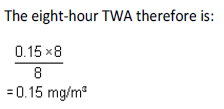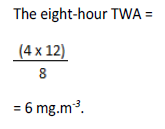 Housing Development Agency Act, 2008
Housing Development Agency Act, 2008
R 385
Occupational Health and Safety Act, 1993 (Act No. 85 of 1993)RegulationsRegulations for Hazardous Chemical Agents, 2020AnnexuresAnnexure 3 : Hazardous Chemical Agent GuidelinesGuidance on medical surveillance and biological monitoringMixed exposuresExamples |
| 89. | The operator works for 7 hours 20 minutes on a process in which he is exposed to an agent hazardous to health. The average exposure during that period is measured as 0,12 mg/m³. |

| 90. | The operator works for eight hours on a process in which he is exposed to an agent hazardous to health. The average exposure during that period is measured as 0,15mg/m³. |

| 91. | Working periods may be split into several sessions for the purpose of sampling to take account of rest and meal breaks, etc. This is illustrated by the following example: |
Exposure is assumed to be zero during the period 10:30 to 10:45, 12:45 to 13:30 and 15:30 to 15:45.
|
Working period |
Exposure (mg/m3) |
Duration of sampling (h) |
|
08:00 - 10:30 |
0,32 |
2,5 |
|
10:45 - 12:45 |
0,07 |
2 |
|
13:30 - 15:30 |
0,20 |
2 |
|
15:45 - 17:15 |
0,10 |
1,5 |
The 8-hour TWA therefore is:

| 92. | An operator works for eight hours during the night shift on a process in which he is intermittently exposed to an agent hazardous to health. The operator's work pattern during the working period should be known and the best available data relating to each period of exposure should be applied in calculating the eight-hour TWA. This data should be based on direct measurement, estimates based on data already available or reasonable assumptions. |

| 93. | The operator works a 12-hour shift each day for five days, and then has seven days’ rest. The exposure limits are based on an eight-hour reference period in each 24 hours in which an exposure occurs; the seven days’ rest makes no difference. While at work, the operator is exposed to 4 mg.m3. |
